How to calculate the number of tiles in the bathroom: installation methods + calculation procedure
Due to the increased humidity, bathrooms are usually tiled - the material is durable and not afraid of water. It is he who is recommended by craftsmen for decorating showers, toilets and pools. The choice of products is impressive in variety - you can choose the finish for every taste and budget.
Before you go to the store, you need to figure out how to calculate the number of tiles in the bathroom, so that later you do not have to look for the missing cladding element. Yes, and I do not want to overpay for surplus either, do you agree?
In the article, we described how the method of laying tiles affects its number, what parameters should be taken into account in the calculations, and also presented three technologies for calculating the consumption of facing material. A detailed example indicating the real parameters of the bathroom will help to make an accurate estimate of the repair work.
The content of the article:
Tile laying methods
Before proceeding with the calculations, it is necessary to determine the layout of the tiles on the floor and walls. There are several variations on the layout of this ceramic material. Also important is the presence of a pattern on the tile. Individually each, and in general, on the surface of the cladding.
Tiled lining according to the pattern of seams happens:
- straight;
- diagonal;
- with offset.
- with inserts from smaller elements.
The easiest way to calculate the volume of materials for the first of these layout options. It is also the easiest to bring to life with self-adhesive tile.
But if you want something unusual, you will have to spend extra money on tiles - for money, and for calculating the required amount - for time. Plus, work in this case also comes out more laborious and expensive.
For example, if you compare the direct and diagonal laying techniques, then with the same surface area to be coated, the first method will require 15–25% less tiles in pieces. In the second case, you will have to cut more tiles, which inevitably leads to the appearance of a mass of unused scraps.
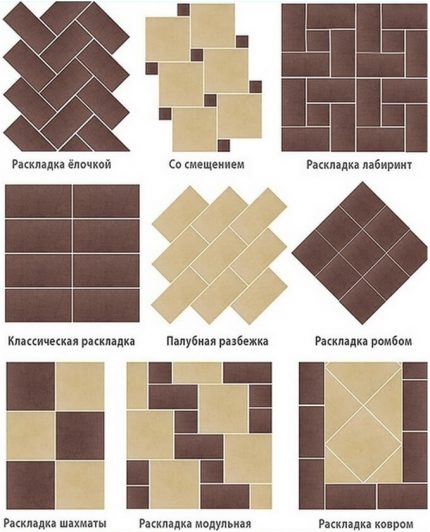
Rules and calculation options
The calculation of the required number of tiles only at first glance seems simple. It is not enough to calculate the quadrature of the surface to be glued and divide it by the area of one tile. In addition to the pattern of seams, many other factors also affect the consumption of the material in question.
When calculating the number of tiles in the bathroom, you should consider:
- the presence or absence of a pattern;
- type of layout;
- place of laying the first tile;
- vertical angles between adjacent walls;
- closed by plumbing or furniture and not requiring surface cladding;
- door and window openings (if there is a bathroom);
- the thickness of the trowel seam is from 2 to 10 mm.
The highlight here is the line from which styling will begin. On the example of the floor - if the first row is laid at one of the walls, then the tile will have to be cut only at the opposite.
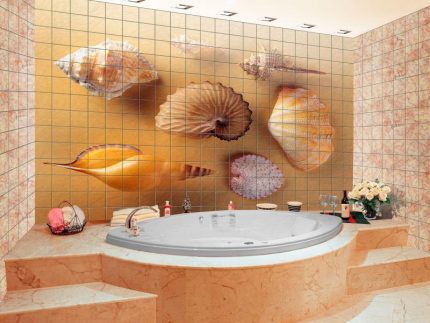
But, you can start laying floor tiles from the center of the room, which often looks more aesthetically pleasing. However, then the trimmed elements will be on both sides. It’s good if you can use trim from one of them for laying next to the other. Otherwise, the amount of material needed for cladding in pieces will increase.
Often, each tile cut ends with a breakdown of the remaining part and the inability to use it further. This often happens if the tiler is inexperienced.
As a result, the consumption of tile material increases sharply due to the need for a large volume of cutting tiles. And this inevitably affects the increase in the required volume of ceramic tiles in pieces.
Another problem spot is the vertical angles on the walls. In old panel high-rise buildings, they are often tilted, which contributes a lot to the cutting of tiles.
Ideally, the horizontal and vertical seams on the wall tile should go strictly perpendicular to each other. Otherwise, the lining is obtained after the sticker is ugly and curved.
But, if the walls are slightly tilted, then from below or from above, in the corners of the bathroom, you have to make thin inserts on them or cut the tile pasted in the row in the row. All this also leads to an increase in its required quantity in pieces.
You should measure the corners in advance using the level or plumb line and decide how to close these shortcomings of the builders.
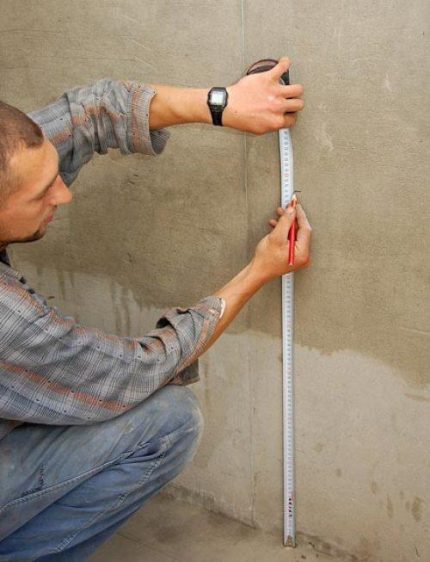
It is often better to insert decorative corners of plastic there from above or to initially edit the walls with plasterboard or plaster. Accurate cutting of tiles due to several millimeters of uneven walls will require a lot of time and effort.
Method # 1 - by area
This calculation method is applicable only for a simple classical layout, and even then with great reservations. Its main drawback is the inability to take into account the additional costs of cutting ceramics when marking the lines of its laying from the center of the room.
To carry out this calculation, you must first measure the size of the bathroom. To calculate the floor area, you need to multiply the width by the length of the room. And for walls - their width to a height and put together all the resulting numbers.

The result should be two values - one for the floor cladding, the second for the wall. Then these numbers are simply divided by the area of one tile selected to decorate a particular surface.
At the same time, there is a doorway on the walls in the bathroom, and often a large mirror is glued to one of the walls. No tile is required for such places. It is also necessary to take this into account by subtracting their area from the area calculated above.
If the diagonal layout is selected, the resulting number of tiles should be increased by at least 15%. With this installation option, tile consumption in the extreme rows inevitably increases.
Method # 2 - in rows
In order to more accurately calculate the number of tiles required, it is best to use the method with an orderly calculation of it. To do this, you need to measure the width and length of the surface to be coated, and then divide them by the width and length of the tile you like.

The essence of the method is simple - first, the number of plates in the row is calculated, and then the number of these rows. At the same time, it is possible to take into account inserts of a smaller border somewhere in the middle and no glued surfaces at all.
When dividing the above numbers, a fractional number is usually obtained. It should always be rounded up. We need to calculate the number of whole tiles. And if in some place you need to glue a piece a couple of centimeters wide, then this is another tiled product for cutting.
Method # 3 - by sketch
The most time-consuming and accurate result is only able to give a calculation with a pre-scaled wall and floor plan. It should be done on graph paper and in strict accordance with the measured dimensions of the bathroom.
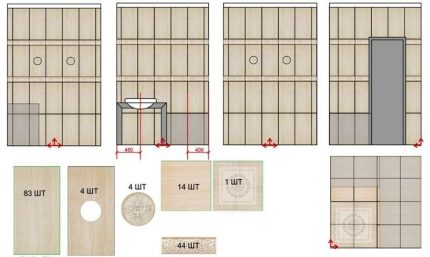
The scheme should be prepared as carefully as possible, taking into account all the glued tile elements and furniture with sanitary ware, for which the cladding is not needed. At the same time, some masters recommend not to put tiles under the bathroom to save material on the floor. Do not do this in any case.
In addition to the decorative role, the floor tile also performs the function of protecting the concrete base (floor) in case of a flood in the bathroom. Leaving one of the sections of the floor unprotected means putting it all at risk of destruction by water.
If some tile completely gets inside the “door” in the sketch in the doorway, then it can be excluded from the calculations. But if such a tile is only partially located in the opening area, then it should be taken into account as a whole element.
In some such cases, it may be possible to cut one tile into a pair of the necessary parts. However, this must be done with caution so that later the purchased material is definitely enough.
It is important to consider additional material if construction shower tray booths or bath screen.
Calculation example for a small bathroom
Suppose there is a bathroom with an area of 2.56 sq.m and has the following parameters:
- height - 2600 mm;
- short side length - 1500 mm;
- the length of the side along which the bath will stand is 1710 mm.
Plus, there is a doorway - 750 * 2000 mm.
The tile for the floor is selected square, size 330 * 330 mm, and for the walls - 200 * 300 mm with a vertical arrangement.
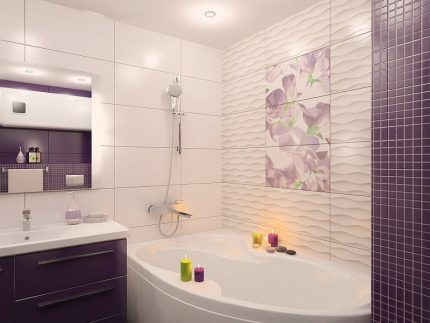
As a result, we get a bathroom with the following data (mm) for calculations:
- room height (H) - 2600;
- opening height (Hp) - 2000;
- the depth of the room (A) - 1500;
- the width of the room (B) - 1710;
- aperture width (Bp) - 750;
- bath length (C) - 1500;
- the width of the bath (D) is 700.
The easiest way to calculate the tile on the floor. First, divide B by the width of the floor tiles 1710/30 = 5.18. With rounding up we get 6 pieces in a row. Then - divide A by the length of the same floor tile 1500/330 = 4.56.Rounding, we get 5 rows. Total: 6 * 5 = 30 tiles per floor.
Moreover, on the one hand in a row we get a trim of about 60 mm (330 * 0.18). If the tile is cut precisely without breakage, then instead of 30, you can take only 28 pieces.
For wall surfaces, the calculations are as follows. For a wall with a door - the top two rows are 9 tiles (1710/200 = 8.55), and another 7 on 5 (2000/200 = 5). In total, 18 + 25 = 43.
The number of rows is calculated as follows:
- for the two upper ones - a clearance of 600 mm above the door with a tile height of 300 mm;
- and the opening itself - 2000/300 = 6.67.
For the wall opposite the door - 1710/200 = 8.55 and 2600/300 = 8.67, we get 9 * 9 = 81 tiles. From this number, you need to subtract 21 pieces per tile, located behind the bathroom. There is no cladding needed.
For two narrow walls - 1500/200 = 7.5 and 2600/300 = 8.67, we get 8 * 9 * 2 = 144. It will be difficult to come up with scraps here.
Total comes out: 144 + 60 + 43 = 247 pieces on the walls and 28 pieces on the floor. Plus, just in case, add 10% spare to these numbers and you can go to the store for a tile.
Conclusions and useful video on the topic
Visual calculation of the number of tiles for a room measuring 1.5 * 1.7 m:
You can learn about the rules for laying out the tiles from the following video:
Preparing a bathroom with a tile layout:
There is nothing prohibitively difficult in calculating bathroom tiles. However, one must be very careful not to make a mistake with calculating the exact amount in pieces. Each bend, corner, duct with pipes, plumbing fixtures and other interior features contribute to these calculations.
Plus, you still have to consider the tile pattern and the type of layout. In this case, the most accurate calculation option is a sketch, which consists in drawing up a plan of the room in millimeters and drawing on it each wall and floor tile.
Do you have personal experience calculating tiles for a bathroom? Want to share your knowledge or ask questions about the topic? Please leave comments and participate in discussions - the feedback form is located below.

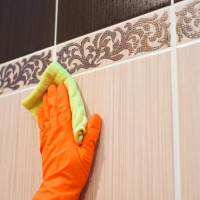 How to remove fungus in the bathroom: the best folk and professional ways
How to remove fungus in the bathroom: the best folk and professional ways  Calculation of pipe parameters: how to correctly calculate the weight, mass and volume of a pipe
Calculation of pipe parameters: how to correctly calculate the weight, mass and volume of a pipe 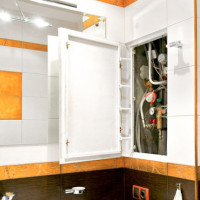 Revision plumbing hatches for the bathroom and toilet: types, placement rules, mounting features
Revision plumbing hatches for the bathroom and toilet: types, placement rules, mounting features 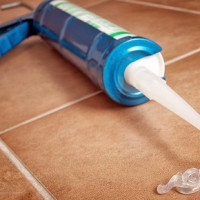 Sealant for the bathroom: types, selection tips and instructions for use
Sealant for the bathroom: types, selection tips and instructions for use  How to work with a grinder: safety measures + instruction manual
How to work with a grinder: safety measures + instruction manual  How to choose a hydraulic pipe bender: types of equipment and its features
How to choose a hydraulic pipe bender: types of equipment and its features  How much does it cost to connect gas to a private house: the price of organizing gas supply
How much does it cost to connect gas to a private house: the price of organizing gas supply  The best washing machines with dryer: model rating and customer tips
The best washing machines with dryer: model rating and customer tips  What is the color temperature of light and the nuances of choosing the temperature of the lamps to suit your needs
What is the color temperature of light and the nuances of choosing the temperature of the lamps to suit your needs  Replacement of a geyser in an apartment: replacement paperwork + basic norms and requirements
Replacement of a geyser in an apartment: replacement paperwork + basic norms and requirements
You can manually count the tiles, of course, but this is for the patient. I use a special program for the computer, pro100. You just need to enter the size of the tile, and then substitute it on the walls and floor. It’s even funny - in the future you can see how the bathroom will look with this particular tile. You can add a photo yourself.
But anyway, you need to take the tile with a margin for trimming and battle, because buying it is sometimes difficult. Not that such a tile is no longer on sale, it simply may differ by a half tone in another batch. This often happens.